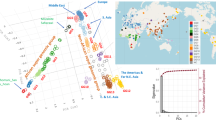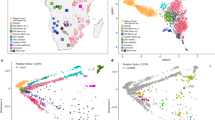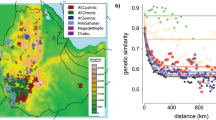Abstract
The renewed emphasis on population-specific genetic variation, exemplified most prominently by the International HapMap Project, is complicated by a longstanding, uncritical reliance on existing population categories in genetic research. Race and other pre-existing population definitions (ethnicity, religion, language, nationality, culture and so on) tend to be contentious concepts that have polarized discussions about the ethics and science of research into population-specific human genetic variation. By contrast, a broader consideration of the multiple historical sources of genetic variation provides a whole-genome perspective on the ways i n which existing population definitions do, and do not, account for how genetic variation is distributed among individuals. Although genetics will continue to rely on analytical tools that make use of particular population histories, it is important to interpret findings in a broader genomic context.
This is a preview of subscription content, access via your institution
Access options
Subscribe to this journal
Receive 12 print issues and online access
$189.00 per year
only $15.75 per issue
Buy this article
- Purchase on Springer Link
- Instant access to full article PDF
Prices may be subject to local taxes which are calculated during checkout
Similar content being viewed by others
References
Collins, F. S. & Mansoura, M. K. The human genome project: revealing the shared inheritance of all humankind. Cancer 91 (Suppl.), 221–225 (2001).
Subramanian, G. et al. Implications of the human genome for understanding human biology and medicine. JAMA 286, 2296–2307 (2001).
Chakravarti, A. Population genetics — making sense out of sequence. Nature Genet. 21, 56–60 (1999).
Kruglyak, L. & Nickerson, D. A. Variation is the spice of life. Nature Genet. 27, 234–236 (2001).
Foster, M. W. & Sharp, R. R. Race, ethnicity, and genomics: social classifications as proxies of biological heterogeneity. Genome Res. 12, 844–50 (2002).
Risch, N. et al. Categorizations of humans in biomedical research: genes, race and disease. Genome Biol. 3, 12 (2002).
Cooper, R. S., Kaufman, J. S. & Ward, R. Race and genomics. N. Engl. J. Med. 348, 1166–1170 (2003).
Burchard, E. G. et al. The importance of race and ethnic background in biomedical research and clinical practice. N. Engl. J. Med. 348, 1170–1175 (2003).
Freeman, H. P. The meaning of race in science — considerations for cancer research — concerns of special populations in the National Cancer Program. Cancer 82, 219–225 (1998).
Collins, F. S. et al. A vision for the future of genomics research. Nature 422, 835–847 (2003).
Goldstein, D. B. & Chikhi, L. Human migrations and population structure: what we know and why it matters. Annu. Rev. Genomics Hum. Genet. 3, 129–152 (2002).
International HapMap Consortium. The International HapMap Project. Nature 426, 789–796 (2003).
Johnson, G. C. L. et al. Haplotype tagging for the identification of common disease genes. Nature Genet. 29, 233–237 (2001).
Collins, F. S., Guyer, M. S. & Chakravarti, A. Variations on a theme: cataloging human DNA sequence variation. Science 278, 1580–1581 (1997).
Zhao, H. Y., Pfeiffer, R. & Gail, M. H. Haplotype analysis in population genetics and association studies. Pharmacogenomics 4, 171–178 (2003).
Morton, N. E. Genetic epidemiology, genetic maps and positional cloning. Phil. Trans. R. Soc. Lond. B 358, 1701–1708 (2003).
Wall, J. D. & Pritchard, J. K. Haplotype blocks and linkage disequilibrium in the human genome. Nature Rev. Genet. 4, 587–597 (2003).
Cardon, L. R. & Abecasis, G. R. Using haplotype blocks to map human complex trait loci. Trends Genet. 19, 135–140 (2003).
Wilson, J. F. et al. Population genetic structure of variable drug response. Nature Genet. 29, 265–269 (2001).
Gabriel, S. B. et al. The structure of haplotype blocks in the human genome. Science 296, 2225–2229 (2002).
Goldstein, D. B. Islands of linkage disequilibrium. Nature Genet. 29, 109–111 (2001).
Daly, M. J. et al. High-resolution haplotype structure in the human genome. Nature Genet. 29, 229–232 (2001).
Calafell, F. Classifying humans. Nature Genet. 33, 435–436 (2003).
Van den Oord, E. J. C. G. & Neale, B. M. Will haplotype maps be useful for finding genes? Mol. Psychiatry 9, 227–236 (2004).
Weiss, K. M. & Clark, A. G. Linkage disequilibrium and the mapping of complex human traits. Trends Genet. 18, 19–24 (2002).
Lai, E. et al. Medical applications of haplotype-based SNP maps: learning to walk before we run. Nature Genet. 32, 353–54 (2002).
Shriver, M. D. et al. Skin pigmentation, biogeographical ancestry and admixture mapping. Hum. Genet. 112, 387–399 (2003).
Bamshad, M. J. et al. Human population genetic structure and inference of group membership. Am. J. Hum. Genet. 72, 578–589 (2003).
Webster, M. T., Clegg, J. B. & Harding, R. M. Common 5′ β-globin RFLP haplotypes harbour a surprising level of ancestral sequence mosaic. Hum. Genet. 113, 123–139 (2003).
Gower, B. A. Using genetic admixture to explain racial differences in insulin-related phenotypes. Diabetes 52, 1047–1051 (2003).
Shifman, S. et al. Linkage disequilibrium patterns of the human genome across populations. Hum. Mol. Genet. 12, 771–776 (2003).
Lin, J. P. et al. Genealogy construction in a historically isolated population: application to genetic studies of rheumatoid arthritis in the Pima Indian. Genet. Med. 1, 187–193 (1999).
Zhou, X. et al. Genome-wide association study of systemic sclerosis susceptibility in a Choctaw Indian population with high disease prevalence. Arthritis Rheum. 48, 2585–2592 (2003).
Thornton, R. American Indian Holocaust and Survival: A Population History since 1492 (Univ. Oklahoma Press, USA, 1987).
Sturm, C. Blood Politics: Race, Culture, and Identity in the Cherokee Nation of Oklahoma (Univ. California Press, USA, 2002).
Carlson, C. S. et al. Additional SNPs and linkage-disequilibrium analyses are necessary for whole-genome association studies in humans. Nature Genet. 33, 518–521 (2003).
Wacholder, S., Rothman, N. & Caporaso, N. Population stratification in epidemiologic studies of common genetic variants and cancer: quantification of bias. J. Natl Cancer Inst. 92, 1151–1158 (2000).
Ziv, E. & Burchard, E. G. Human population structure and genetic association studies. Pharmacogenomics 4, 431–441 (2003).
Weiss, K. M. & Terwilliger, J. D. How many diseases does it take to map a gene with SNPs? Nature Genet. 26, 151–157 (2000).
Cardon, L. R. & Palmer, L. J. Population stratification and spurious allelic association. Lancet 361, 598–604 (2003).
Foster, M. W. & Aston, C. E. A practice approach for identifying previously unsuspected environmental contributors to SLE and other complex diseases. Environ. Health Persp. 111, 593–597 (2003).
Zondervan, K. T. & Cardon, L. R. The complex interplay among factors that influence allelic association. Nature Rev. Genet. 5, 89–100 (2004).
Sankar, P. & Cho, M. K. Toward a new vocabulary of human genetic variation. Science 298, 1337–1338 (2002).
Jorde, L. B., Watkins, W. S. & Bamshad, M. J. Population genomics: a bridge from evolutionary history to genetic medicine. Hum. Mol. Genet. 10, 2199–2207 (2001).
Broder, C. & Venter, J. C. Whole genomes: the foundation of new biology and medicine. Curr. Opin. Biotechnol. 11, 581–585 (2000).
Cavalli-Sforza, L. L., Menozzi, P. & Piazza, A. The History and Geography of Human Genes (Princeton Univ. Press, USA, 1994).
Rosenberg, N. A. et al. Genetic structure of human populations. Science 298, 2381–2385 (2002).
Pritchard, J. K. & Cox, N. J. The allelic architecture of human disease genes: common disease–common variant... or not? Hum. Mol. Genet. 11, 2417–2423 (2002).
Reich, D. E. & Lander, E. S. On the allelic spectrum of human disease. Trends Genet. 17, 502–510 (2001).
Sebastiani, P. et al. Minimal haplotype tagging. Proc. Natl Acad. Sci. USA 100, 9900–9905 (2003).
Weiss, K. M. & Terwilliger, J. D. How many diseases does it take to map a gene with SNPs? Nature Genet. 26, 151–157 (2000).
Clark, A. G. Finding genes underlying risk of complex disease by linkage disequilibrium mapping. Curr. Opin. Genet. Devel. 13, 296–302 (2003).
Smith D. J. & Lusis A. J. The allelic structure of common disease. Hum. Mol. Genet. 11, 2455–2461 (2002).
Reich, D. E. et al. Human genome sequence variation and the influence of gene history, mutation and recombination. Nature Genet. 32, 135–142 (2002).
Tishkoff, S. A. & Williams, S. M. Genetic analysis of African populations: human evolution and complex disease. Nature Rev. Genet. 3, 611–621 (2002).
Acknowledgements
This publication was made possible by grants from the National Institute on Environmental Health Sciences and from the National Human Genome Research Institute. Its contents are solely the responsibility of the authors and do not necessarily represent the official views of the NIEHS, NHGRI or the National Institutes of Health. We also are grateful for comments made by L. D. Brooks and two anonymous reviewers on an earlier version.
Author information
Authors and Affiliations
Corresponding author
Ethics declarations
Competing interests
The authors declare no competing financial interests.
Related links
Related links
DATABASES
Entrez
OMIM
FURTHER INFORMATION
Glossary
- ADMIXTURE
-
Gene flow between differentiated populations.
- BLOOD QUANTUM
-
A legal measure of degree of Native American ancestry. The designation of 'full blood' or some fraction such as 'quarter' or 'half' blood quantum depends on how one's nineteenth century Indian ancestors were designated (often arbitrarily) and the blood quanta of subsequent ancestors who were enrolled in federally recognized tribes.
- COMMON DISEASE/COMMON VARIANT HYPOTHESIS
-
The view that one or a few genetic contributors account for significant numbers of cases of many common, complex diseases in most or all populations.
- FOUNDER EFFECT
-
A situation in which a new population is founded by a small number of individuals. Similar to a bottleneck, the founder effect severely reduces genetic diversity, increasing the effect of random drift.
- MICROSATELLITE
-
A class of repetitive DNA sequences that are made up of tandemly organized repeats that are 2–8 nucleotides in length. They can be highly polymorphic and are frequently used as molecular markers in population genetics studies.
- POPULATION BOTTLENECK
-
A marked reduction in population size followed by the survival and expansion of a small random sample of the original population.
- POPULATION STRATIFICATION
-
Subdivision of a population into different subgroups with potentially different marker allele frequencies and different disease prevalences. This might result in participants with a disease having different allele frequencies than those without the disease that are recruited as controls.
- PROSPECTIVE COHORT
-
Longitudinal study of individuals initially assessed for exposure to certain risk factors and then followed over time to evaluate the progression towards specific outcomes (often disease).
Rights and permissions
About this article
Cite this article
Foster, M., Sharp, R. Beyond race: towards a whole-genome perspective on human populations and genetic variation. Nat Rev Genet 5, 790–796 (2004). https://doi.org/10.1038/nrg1452
Issue Date:
DOI: https://doi.org/10.1038/nrg1452
This article is cited by
-
Re-situations of scientific knowledge: a case study of a skirmish over clusters vs clines in human population genomics
History and Philosophy of the Life Sciences (2022)
-
The Confounding of Race in High School Biology Textbooks, 2014–2019
Science & Education (2020)
-
Functional SNP allele discovery (fSNPd): an approach to find highly penetrant, environmental-triggered genotypes underlying complex human phenotypes
BMC Genomics (2017)
-
Is Racial Profiling More Benign in Medicine Than Law Enforcement?
The Journal of Ethics (2011)
-
The use of race, ethnicity and ancestry in human genetic research
The HUGO Journal (2011)



